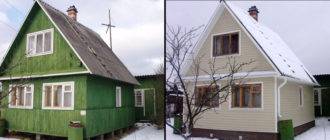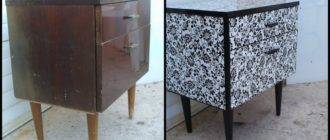If your house or cottage has a staircase, then it is extremely important to think over its lighting. Otherwise, if this is not done, going up and down it will be extremely dangerous, not to mention a simple inconvenience. If you want to figure out how to properly organize the lighting of the stairs in a cottage, then this article will help in this matter.

Features of the operation of the stairs
The use of such structures is a necessity if the house has two or more floors. However, already at the design stage, one should take into account the structure of the steps, their size, the height of each march. Since, walking on them, a person must, simply must feel firm support under his feet, not worry and be confident in his complete safety.
After all, the likelihood of falling from an uncomfortable ladder is extremely high. Of course, you should not discard the clumsiness of some people, but still, if you initially think over the design of the steps, and also organize high-quality staircase lighting, the probability of falling and getting injured sharply decreases and confidently tends to zero.
Aesthetic properties without sacrificing performance
When designing this element, one should not forget about the aesthetic properties, which should include:
- the material from which the steps will be created;
- the material with which they will be faced;
- the size of each step;
- the presence of beautiful stair railings;
- the presence of light sources, etc.
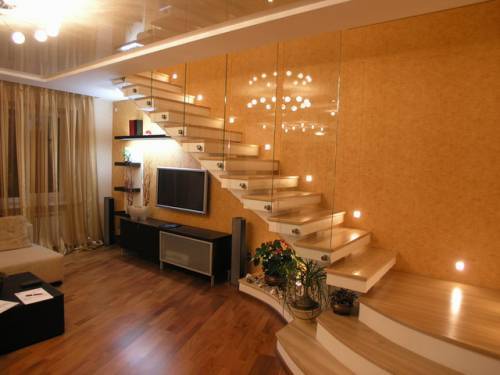
What to look for
Before organizing the lighting of flights of stairs, it is necessary to pay attention to a number of factors. In particular, consider whether there are sources of natural light.
They can be:
- windows and stained-glass windows in the side wall;
- small openings in the side wall;
- windows or stained-glass windows at the top, next to the steps;
- windows or stained-glass windows at the bottom, next to the steps.
The presence of natural light greatly simplifies the task. Although, of course, this does not mean that there is no need to install lamps. Indeed, in the dark, people also use marches.
However, you should not rely on sunlight either, because there are quite cloudy days, especially in autumn and winter, when there is very little natural light.
Lighting types
In this section, we will take a closer look at the various types of lamps, as well as how you can organize the lighting of the steps of the stairs with your own hands.
Currently, there are several main options for arranging marches:
- "Palace" or ceremonial lighting;
- with the use of sconces;
- using cables;
- using automatic devices.
Three types of lighting fixtures
In this case, it is recommended to use one of three types of lighting fixtures:
- local type;
- wall type;
- ceiling type.
Below we will tell you more about each of them, as well as what type of lighting they belong to.
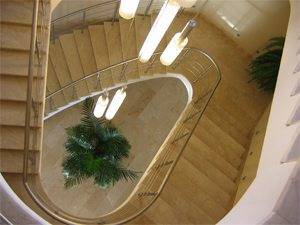
Ceiling type appliances
If you want to equip staircase lighting with ceiling devices, then it is recommended to install pendant chandeliers, including overall ones.
They can be of two types:
- with suspensions;
- without suspensions.
Chandeliers are mounted directly to the ceiling, have a high power, and therefore one fixture can give light enough for several spans at once.
Also, this type is usually called ceremonial or palace, and most often they are mounted on marches, which are dominant in the design of the entire floor, that is, they occupy the largest space.
In addition, this option may be the only possible if the steps are installed clearly in the center of the room, and therefore do not adjoin the walls, where natural light sources can refuse.
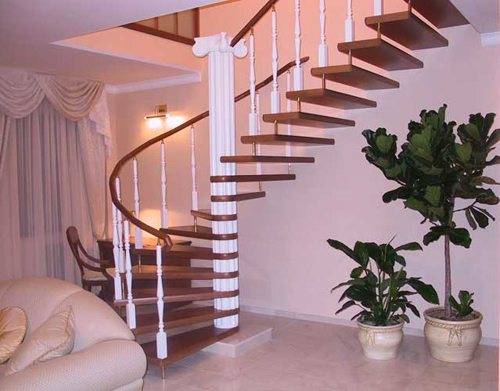
If you have a large, dimensional staircase, then in this case, you should mount chandeliers with a long suspension, for example, about three meters.
Most often they have an original appearance:
- with long pendants made of natural glass or even solid crystal;
- spiral models;
- models with "columns";
- models with cascading decorations.
Most often, such models are equipped with chains that allow you to determine the length of the suspension, but the designers recommend hanging them as close to the ceiling as possible, which will ensure an even distribution of light - from the top flight to the bottom floor.
Wall-mounted devices
Lighting of stairwells by means of wall-mounted appliances is widespread, which fully include sconces.
Fortunately, today there is a large selection of models made in various styles, among which the following stand out:
- minimalistic;
- techno;
- Provencal;
- modern;
- baroque and many others.
When choosing them, the main thing is to take into account the general interior design, which is used in the design of a particular room.
This type of fixture, regardless of style, is different:
- restraint;
- practicality;
- small dimensions;
- ease of installation.
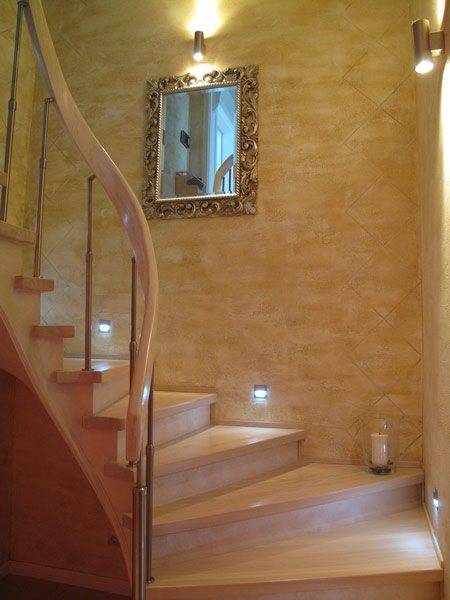
Another advantage of sconces is that manufacturers today offer potential consumers a large selection of models with the ability to install lamps of various types:
- incandescent;
- neon;
- halogen;
- LED and many others.
Particularly noteworthy are the lampshades that are used in the sconces. Thanks to their design, they scatter light in an amazing way, making it softer and more subdued.
As a material for the manufacture of shades, manufacturers use:
- high quality glass;
- silicone;
- transparent plastic;
- solid, natural crystal, etc.
Advice. If you want to use sconces to provide lighting on the stairs and you need several items, be sure to purchase models from the same collection, which will ensure the integrity of the interior.
It is extremely important not to be mistaken with the location of the sconce. In this case, the instruction provides the following placement features:
- a person climbing the steps should not touch their shoulder or head (this is especially important if the staircase is narrow);
- thus, the optimal height is not lower than 1 m 85 cm.
Advice. Do not overdo it. The sense of proportion, which is important in all aspects of human life, is also relevant here. In particular, we are talking about the fact that the size of the chandelier for staircases should not be too large, otherwise you will simply overload the interior.
When the rope type is used
The so-called cable systems are relevant if you have an overall staircase in your house. The staircase lighting scheme in this case provides for the presence of devices that are installed:
- from ceiling to floor;
- located between the spans.
- This method has many advantages, among which the ability to move the light source along the cable to the place you need stands out.
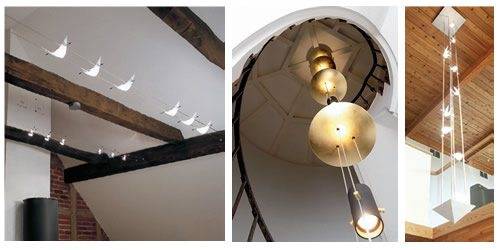
Local lighting type
Such devices allow only local backlight, that is, each step separately or generally separate steps. To a greater extent, they play mainly a decorative role and help to emphasize the beauty of the steps, the originality of the finishing material.
There are several types of installation:
- installation in the wall slightly above the plane of a separate step;
- installation under a separate stage, which will effectively illuminate the lower stage;
- installation directly into the upper area of a separate step, but in this case the entire staircase does not look very presentable.
By the way, the latter option will lead to heating of the steps, which makes it impossible to walk on them barefoot.
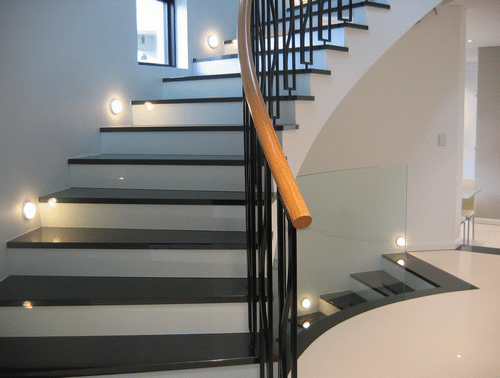
If you have chosen this type of devices, then please note that they have the following markings:
- IP 65;
- IP 66.
Such devices have additional protection against:
- dust penetration;
- from moisture penetration.
Automatic type
This method is becoming more and more common as a conventional, standard circuit breaker has low efficiency. And it is not always clear where it is better to install it - above or below. After all, if you install it only at the bottom, then how can you turn off the light, going up to the second floor?
Therefore, it is necessary to install an automatic staircase lighting:
- you can turn on the light at the bottom;
- turn off at the top when you go up the stairs;
- and vice versa.
Of course, you can consider the option of installing a timer, the price of which is not that high, but it should be noted that their effectiveness is extremely doubtful. After all, you need to have time to climb in the allotted time.
Motion sensors are more effective:
- turn on when moving on the stairs;
- turn off after some time of inactivity;
- the possibility of installing a sensor with an additional function that determines the level of natural light, which makes it possible to exclude switching on in the event of a sufficient amount of daylight.
In conclusion
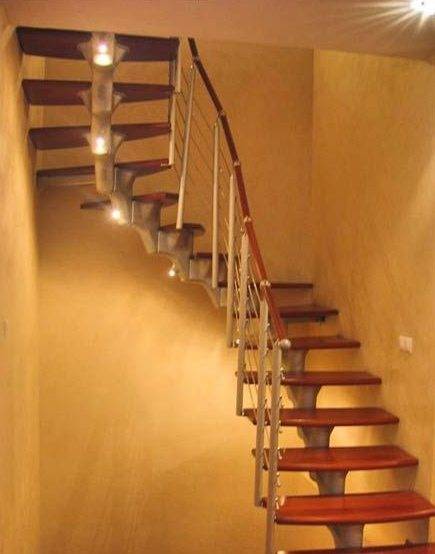
How to make a metal frame for stairs "width =" 640 ″ height = "360 ″ frameborder =" 0 ″ allowfullscreen = "allowfullscreen">
Also, do not forget about the need to maintain the harmony of the overall interior design. In this case, even in the photo, a staircase with installed lighting devices will look presentable and cause an irresistible desire to climb it!
In the video presented in this article, you will find additional information on this topic (also learn how to make a metal frame for a staircase).

